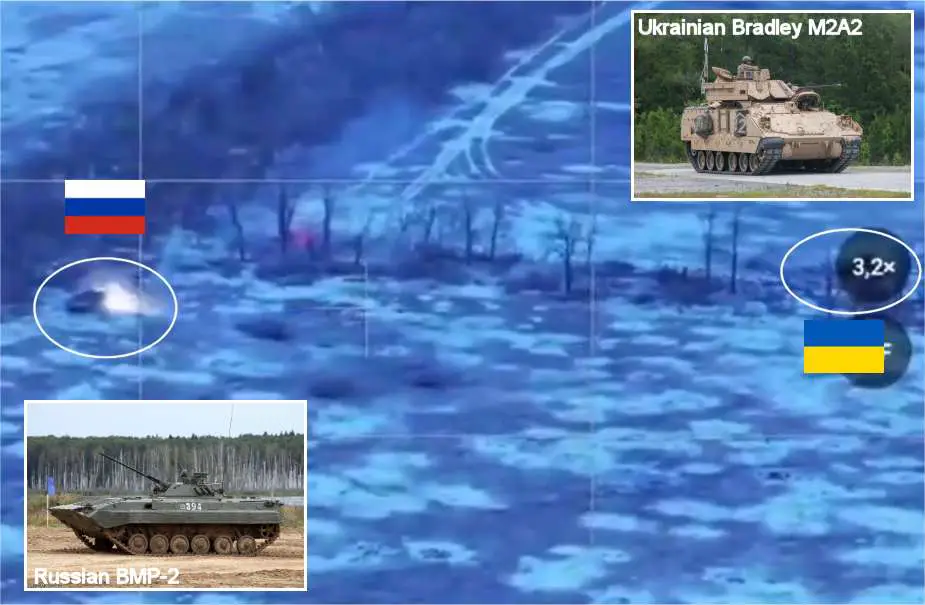In a rare close-quarters battle, a Ukrainian M2A2 ODS Bradley Infantry Fighting Vehicle (IFV) encountered a Russian BMP infantry fighting vehicle, providing a striking example of the intensity of combat on the front. This engagement, captured by a Ukrainian drone, took place near the Stepove suburb of Avdiivka on December 13, 2023.
Follow Army Recognition on Google News at this link

A Ukrainian M2A2 ODS Bradley IFV fought against a Russian BMP IFV (Picture source: OSINT/open source information)
The Bradley, provided by the United States and operated by the Ukrainian 47th Assault Brigade, faced an uncertain adversary - possibly a BMP-2 or a more armored BMP-3. The battle took place amidst tree lines, offering limited cover against overhead drones.
The Bradley, equipped with superior thermal sights, appeared to have detected the BMP first. Utilizing its M242 Bushmaster automatic cannon, the Bradley unleashed M792 high-explosive incendiary fragmentation shells, some detonating on impact with trees and others striking the BMP. Caught by surprise, the BMP attempted a hasty escape, exposing its weaker armor to more shell fire.
The BMP then inadvertently entered the blast radius of a 155mm cluster shell, suffering additional impacts. The video ends with the fate of the BMP unresolved, but the signs were ominous.
The 47th Brigade has effectively used the Bradley on the Avdiivka front. Despite their robustness, Bradleys are not invulnerable, with confirmed losses and damages in ongoing conflicts. Russia, on the other hand, has suffered significant BMP losses throughout the conflict. The recent capture of a Bradley by Russian forces is also noteworthy.
The Bradley was developed as a response to the Soviet BMP series, offering superior armor and firepower. Although both vehicles are equipped with anti-tank guided missiles, the engagement at Stepove highlights the crucial role of first detection and engagement in determining the outcome of the battle.
The M2A2 Bradley and BMP-2 are two infantry fighting vehicles (IFVs) that embody the divergent military doctrines of the West and East during the Cold War. The M2A2 Bradley, developed by the United States, and the BMP-2, designed in the Soviet Union, have distinct technical characteristics reflecting their respective strategies and operational priorities.
The M2A2 Bradley, with its reinforced armor, offers better protection against enemy fire. Its thicker armor makes it more resistant, especially against artillery shells and small-caliber munitions. In comparison, the BMP-2, though lighter and more agile, has relatively thinner armor, making it more vulnerable to direct impacts. This difference in armor is a clear representation of the design philosophy: the Bradley prioritizes protection and crew survival, while the BMP-2 focuses on mobility and versatility.
In terms of armament, the M2A2 Bradley is equipped with a 25 mm Bushmaster M242 automatic cannon capable of firing a variety of munitions and is also equipped with TOW missiles for long-range anti-tank engagements. The BMP-2, on the other hand, is armed with a 30 mm automatic cannon, providing effective firepower against infantry and light vehicles. It also has anti-tank missiles, but their effectiveness is often considered inferior to the Bradley's TOW missiles.
Mobility is another aspect where these vehicles differ. The BMP-2, being lighter, offers better maneuverability and higher speed, advantageous in varied terrain and for rapid maneuvers. The Bradley, heavier due to its armor and armament, is less agile but compensates with increased stability and durability, particularly important in intense combat environments like the one shown in the video.
The M2A2 Bradley and BMP-2 illustrate two different approaches in the design of infantry fighting vehicles. The Bradley emphasizes protection and firepower, while the BMP-2 favors mobility and troop-carrying capacity. These differences underscore the distinct strategies and objectives of the armed forces for which they were developed.
This engagement underscores the critical importance of technology, intelligence, and crew proficiency in modern armored warfare. The Bradley's first strike against the BMP, facilitated by various factors, proved decisive in this battle near Avdiivka.















